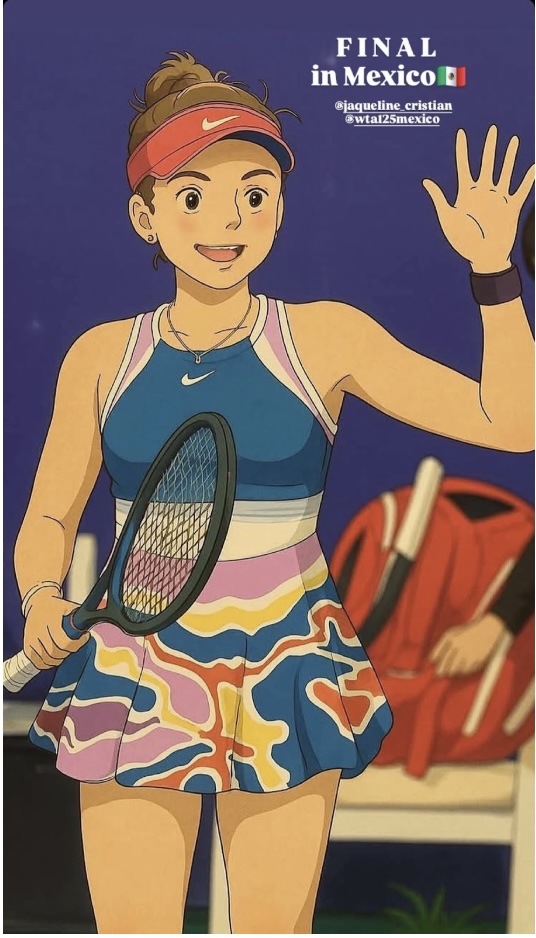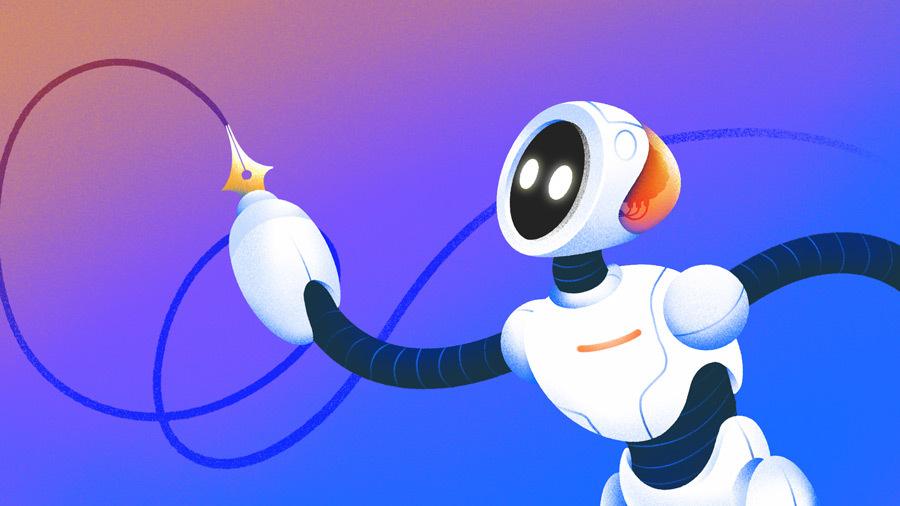This, from her Instagram on Saturday, is Jaqueline Cristian, the top-ranked Romanian women’s professional tennis player and the 61st ranked woman player in the world.
This, a fan creation that Cristian uploaded to her Instagram, is also, evidently, Jaqueline Cristian, which is deeply problematic.

Last week, the Studio Ghibli AI controversy entered our timelines, disgusting its founder and raising deep concerns about the state of intellectual property law and how it applies to the rapidly advancing world of artificial intelligence.
If an artist’s work — especially one as distinctive and culturally significant as Studio Ghibli’s — can be copied, modified and distributed by AI without consequence, then we may have crossed an irrevocable line. This situation does not merely present a challenge to copyright law but threatens to upend the entire foundation of how we define creative ownership.
At the heart of this issue is the question of what intellectual property law protects and how those protections apply when AI is involved.
Copyright’s original intent
Copyright law has traditionally shielded artistic works from unauthorized reproduction and distribution, ensuring that creators retain control over their intellectual and artistic output. Under the Berne Convention for the Protection of Literary and Artistic Works, which became the Paris Act in 1971, original works of authorship — such as films, illustrations and designs — are protected the moment they are created, requiring no formal registration.
This is the very law that safeguards the hand-drawn artistry of Studio Ghibli from being reproduced by others without authorization. However, these protections were drafted with human creators in mind, not machines that can be trained on millions of images and instantly generate works that mimic a particular style.
One of the key problems with AI-generated art is that while specific works are protected under copyright, style itself is not. Studio Ghibli’s films are a unique artistic canon, composed of thousands of unique illustrations, all of which are protected under copyright law. But an AI model that has been trained on these works can produce art that “looks like” a Studio Ghibli creation without directly copying a specific frame, such as in the AI creation of Jaqueline Cristian, above.
From a legal standpoint, this distinction creates a loophole that AI companies exploit. They argue that since the generated images are not direct copies, they do not infringe on copyright. This technicality makes it incredibly difficult for studios such as Ghibli to take legal action against AI-generated replicas.
This argument only addresses the letter of the law and ignores the spirit of intellectual property law, which exists to protect the originality of creative works and ensure that their creators receive recognition and control over how their work is used.
The entire premise of copyright is that those who invest time, effort and creativity into producing something original should not have their work taken, modified or commercialized by others without permission. AI-generated art that mimics Studio Ghibli’s distinct look undermines this principle by allowing machines — and the companies that operate them — to benefit from the studio’s decades of artistic innovation without any form of compensation or credit.
There is a very strong argument that the process by which AI learns to generate this type of artwork is itself legally questionable. AI models do not create in a vacuum; they are trained on massive datasets that include existing artworks, often scraped from the internet without permission from the original creators.
Many AI companies claim that this practice falls under “fair use,” a doctrine in copyright law that allows limited use of copyrighted material without permission under specific circumstances, such as for education, commentary or parody.
However, fair use is not an absolute right, and courts evaluate it based on factors like the purpose of the use, the nature of the original work, the amount of the work used, and its effect on the market. AI companies that scrape copyrighted works without permission and then use them to generate art that competes with the originals in the marketplace may not meet the fair use standard.
Mimicry’s monetary consequences
In the case of Studio Ghibli, the AI-generated works are not being created for commentary or educational purposes — they are being used to produce marketable images that mimic the studio’s signature aesthetic.
This could have a direct economic impact on Studio Ghibli and the artists who work within that style. If companies or individuals can generate Ghibli-style artwork without hiring a professional animator or illustrator, that undermines the value of Studio Ghibli’s brand and the livelihoods of artists who specialize in this form of art.
Courts have historically ruled against uses of copyrighted material that create direct market competition with the original works. Where AI-generated Ghibli-style images interfere with the market for official Ghibli artwork and related licensed products, they should not be protected under fair use.
Another critical issue is the potential for misrepresentation and consumer confusion. Studio Ghibli has spent decades cultivating its distinctive artistic style, which is now synonymous with the studio’s brand identity.
Blurred lines
When AI-generated art replicates that style, it creates a risk that consumers may believe they are looking at an official Ghibli-sanctioned work when, in fact, they are not. In other words, this adds to the last thing we need in 2025 and beyond — an enhanced inability to determine what is real and what is fake.
This brings trademark law into the equation. While copyright protects original works, trademarks protect brand identities — including distinctive visual styles associated with a particular company. If AI-generated art misleads consumers into believing it is affiliated with Studio Ghibli, the studio could argue that this constitutes trademark infringement under the Lanham Act, which prohibits the unauthorized use of trademarks in a way that causes consumer confusion.
The reality is that enforcing these protections in the context of AI is very challenging. Most intellectual property laws were written before AI-generated content was even conceivable, meaning they do not provide clear guidance on how to handle situations where machines create works that closely resemble those of human artists.
We need legislative reform to close these loopholes and ensure that artists and studios retain control over their work in the age of AI. Some proposed solutions include requiring AI companies to obtain explicit permission before using copyrighted works in training datasets, establishing clearer rules around the commercial use of AI-generated art, and developing new forms of intellectual property protection that apply specifically to artistic styles.
Devaluing human creativity
The Studio Ghibli controversy is not an isolated case — it is part of a much larger debate about the role of AI in creative industries. From visual art to music to literature, AI is increasingly being used to generate content that competes with human-made works. If left unchecked, this could lead to a future in which human creativity is devalued, and artists find themselves unable to protect their own work from being absorbed and regurgitated by machines.
If we really think about it with some depth, intellectual property law is, at its core, about balance. IP law should seek to encourage innovation and creativity while ensuring that creators are fairly compensated for their work.
AI has the potential to be a powerful tool for artists, but only if its use is governed by ethical and legal safeguards that respect the rights of original creators. The ability of AI to replicate Studio Ghibli’s art style without permission represents a dangerous step toward a world where artistic innovation can be freely harvested by machines, with little regard for the people behind it. If we fail to address these issues now, we risk eroding the foundations of intellectual property law and, with it, the incentive for human artists to continue pushing the boundaries of creativity.
The danger is not just that AI can copy Ghibli today — it is that, if unchecked, AI will soon be able to replicate any artist’s work, making originality meaningless. We are standing on the precipice of a world where anything can be copied, tweaked and sold without regard for who originally created it.
If we allow that to happen, we will have fundamentally changed what it means to be an artist. And once we cross that line, there may be no going back.
Aron Solomon is the chief strategy officer for Amplify. He holds a law degree and has taught entrepreneurship at McGill University and the University of Pennsylvania, and was elected to Fastcase 50, recognizing the top 50 legal innovators in the world. His writing has been featured in Newsweek, The Hill, Fast Company, Fortune, , CBS News, CNBC, USA Today and many other publications. He was nominated for a Pulitzer Prize for his op-ed in The Independent exposing the NFL’s “race-norming” policies.
Related reading:
Illustration: Dom Guzman

Stay up to date with recent funding rounds, acquisitions, and more with the
Crunchbase Daily.








